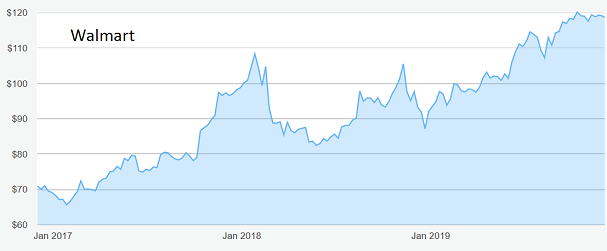Still time to buy a share of world's largest retail chain
After a record Black Friday, the outlook for retailers improved, and they don’t get bigger than this.
4th December 2019 09:55
by Rodney Hobson from interactive investor
After a record Black Friday, the outlook for retailers improved, and they don’t get bigger than this.

Rodney Hobson is an experienced financial writer and commentator who has held senior editorial positions on publications and websites in the UK and Asia, including Business News Editor on The Times and Editor of Shares magazine. He speaks at investment shows, including the London Investor Show, and on cruise ships. His investment books include Shares Made Simple, the best-selling beginner's guide to the stock market. He is qualified as a representative under the Financial Services Act.
The US retail sector is holding up remarkably well despite worries over the disruption caused by consumers switching to online sales and by President Donald Trump’s tariff wars. The big selling weekend just ended, including Black Friday and Cyber Monday, has gone better than many analysts had feared, and the sector can look forward to the important Christmas season with confidence.
With Thanksgiving falling late this year, on 28 November, the Christmas selling season that traditionally starts the following day is squeezed, so it was important to get off to a strong start.
Admittedly, Americans are not breaking down the doors at dawn on Black Friday as they once did – nearly 60% of US consumers turned out for the sales four years ago but the figure is down to about 36% now – but the National Retail Federation reckons US consumers will spend an average of $1,048 this festive season, up about 4% on last year.
- Get exposure to the world’s biggest companies via these ii Super 60 recommended funds
- Fashion retail shares to back this Christmas
"Consumers are in good financial shape and willing to spend a little more on gifts for the special people in their lives this holiday season," Matthew Shay, chief executive of the NRF said optimistically this weekend. The retail industry remains confident that the strong labour market will continue to propel consumer spending.
In fact, many consumers decided not to wait for Black Friday and, lured by early cut-price offers, abandoned their turkeys on Thursday to pile up purchases a day early.
The key factor is the switch to online shopping, with more than half of Americans now doing most of their buying on the Internet. Online spending on Thanksgiving Day was estimated to be 15% higher than a year ago.
While Amazon (NASDAQ:AMZN) has been the major beneficiary of this trend, it also helps traditional brick-and-mortar chains such as Walmart (NYSE:WMT) and Macy's (NYSE:M) that have evolved to embrace the new sales channels.
The impact of tariffs on China is more problematic and is an issue that could cloud the future of the sector, as the country is a major supplier of goods to US retailers. Despite several false dawns, no agreement is in sight. Richard Hunter, interactive investor’s head of markets, reported in September that retailers were warning of potential hits to profits as new tariffs came into force.
Walmart is seen as a heavyweight that has the scope to rearrange its supply chain and squeeze suppliers to trim prices, although it may have difficulty in passing on higher costs from tariffs.

Source: interactive investor Past performance is not a guide to future performance
Walmart reported a solid third-quarter performance to 31 October, with revenue up 2.5% on the previous third-quarter to $128 billion and pre-tax profits soaring 70% to $4.37 billion. The gains were mainly in the US. Over the first nine months of 2019, pre-tax profits more than doubled to $14.44 billion on revenue up 1.8% to $379.32 billion.
The group now expects underlying earnings per share for its current financial year ending 31 January to increase slightly from the $4.91 recorded in the previous year.
It is important that the new chief executive of Walmart US, John Furner, carries on the good work there and brings new impetus to what is the most important part of the group. Furner was head of Sam’s Club, Walmart’s members only warehouse club.
Walmart shares had a good run from $86 just before last Christmas to a peak of $121 three weeks ago. They have come off the boil and, at under $119, represent a buying possibility. The yield is admittedly a little thin at 1.77%, but the price/earnings ratio of 23.9 should not prove too demanding given the way the US economy is holding up and does not allow for any easing of trade tensions should that happen.
Hobson’s choice: Buy for as long as the share price remains below the recent high of $121.
Rodney Hobson is a freelance contributor and not a direct employee of interactive investor.
These articles are provided for information purposes only. Occasionally, an opinion about whether to buy or sell a specific investment may be provided by third parties. The content is not intended to be a personal recommendation to buy or sell any financial instrument or product, or to adopt any investment strategy as it is not provided based on an assessment of your investing knowledge and experience, your financial situation or your investment objectives. The value of your investments, and the income derived from them, may go down as well as up. You may not get back all the money that you invest. The investments referred to in this article may not be suitable for all investors, and if in doubt, an investor should seek advice from a qualified investment adviser.
Full performance can be found on the company or index summary page on the interactive investor website. Simply click on the company's or index name highlighted in the article.
Disclosure
We use a combination of fundamental and technical analysis in forming our view as to the valuation and prospects of an investment. Where relevant we have set out those particular matters we think are important in the above article, but further detail can be found here.
Please note that our article on this investment should not be considered to be a regular publication.
Details of all recommendations issued by ii during the previous 12-month period can be found here.
ii adheres to a strict code of conduct. Contributors may hold shares or have other interests in companies included in these portfolios, which could create a conflict of interests. Contributors intending to write about any financial instruments in which they have an interest are required to disclose such interest to ii and in the article itself. ii will at all times consider whether such interest impairs the objectivity of the recommendation.
In addition, individuals involved in the production of investment articles are subject to a personal account dealing restriction, which prevents them from placing a transaction in the specified instrument(s) for a period before and for five working days after such publication. This is to avoid personal interests conflicting with the interests of the recipients of those investment articles.